Abstract
Multiday ultra-endurance races present athletes with a significant number of physiological and psychological challenges. We examined emotions, the perceived functionality (optimal-dysfunctional) of emotions, strategies to regulate emotions, sleep quality, and energy intake-expenditure in a four-man team participating in the Race Across AMerica (RAAM); a 4856km continuous cycle race. Cyclists reported experiencing an optimal emotional state for less than 50% of total competition, with emotional states differing significantly between each cyclist over time. Coupled with this emotional disturbance, each cyclist experienced progressively worsening sleep deprivation and daily negative energy balances throughout the RAAM. Cyclists managed less than one hour of continuous sleep per sleep episode, high sleep latency and high percentage moving time. Of note, actual sleep and sleep efficiency were better maintained during longer rest periods, highlighting the importance of a race strategy that seeks to optimise the balance between average cycling velocity and sleep time. Our data suggests that future RAAM cyclists and crew should: 1) identify beliefs on the perceived functionality of emotions in relation to best (functional-optimal) and worst (dysfunctional) performance as the starting point to intervention work; 2) create a plan for support sufficient sleep and recovery; 3) create nutritional strategies that maintain energy intake and thus reduce energy deficits; and 4) prepare for the deleterious effects of sleep deprivation so that they are able to appropriately respond to unexpected stressors and foster functional working interpersonal relationships.
Key Points.
Completing the Race Across AMerica (RAAM); a 4856km continuous cycle race associated with sleep disturbance, an energy-deficient state, and experiencing intense unwanted emotions.
Cyclists reported experiencing an optimal emotional state for less than 50% of total competition and actual sleep and sleep efficiency was better maintained during longer rest periods.
-
We suggest that future RAAM cyclists and crew should:
Identify individual beliefs on the perceived functionality of emotional states in relation to best (optimal) and worst (dysfunctional) performance as the starting point to identifying if emotion regulation strategies should be initiated.
Plan for enhanced sleep and recovery not just plan and train for maintaining a high average velocity;
Create nutritional strategies that maintain energy intake and thus reduce energy deficits;
Psychologically prepare cyclists and crew for the deleterious effects of sleep deprivation so that they both are able to appropriately respond to unexpected stressors and foster functional interpersonal working relationships.
Key words: Emotion regulation, mood, sleep, energy expenditure, ultra-endurance exercise
Introduction
The Race Across AMerica (RAAM) is a continuous bicycle race in which competitors cover over 4,800 km in under 12 days. Regardless of whether cyclists ride the RAAM as a solo competitor or part of a relay team, it requires cyclists to exercise at a relatively high intensity continuously for consecutive days. Multiday, ultra-endurance athletes routinely encounter a number of acute physiological and environmental challenges that may include insufficient energy intake (Knechtle et al., 2005; Hulton et al., 2010), dehydration (Bowen et al., 2006), elevations in biomarkers of sympathetic stress (Schumacher et al., 2011) and cardiac damage (Williams et al., 2011), sleep deprivation (Knechtle et al., 2005; Smith et al., 1998), and intense unwanted emotions (Lane and Wilson, 2011; Pedlar et al., 2007). A recent study examining the same four-man RAAM team reported in the present study, found that each cyclist was in a negative energy state throughout the event, and cyclists consumed significantly less energy in the first three days compared to the later days of the race (Hulton et al., 2010). This was despite making a conscious effort to maintain nutrition and hydration strategies based upon recommendations for ultra-endurance exercise (Burke, 2001; Jeukendrup et al., 1997; 2005; Walsh et al., 1994).
Few studies have used a multidisciplinary approach to examine changes in emotions, sleep quality and nutritional status during ultra-endurance events (Pedlar et al., 2007). Appropriate emotional responses might be beneficial to an athlete by, for example, improving the economy of movement (Beedie et al., 2012), improving the quality of interaction with teammates, and reducing the risk of injury (see Lane et al., 2012 for review). Evidence indicates emotions associate with performance (Beedie et al., 2000) and that athletes are more likely to try to regulate an emotion if they believe that doing so will facilitate performance (Lane et al., 2011; 2012).
Emotion-performance relationships tend to be highly individualized (Hanin, 2010). Research has found that pleasant emotions are not always associated with optimal-functional performance and unpleasant emotions associated with unsuccessful or dysfunctional performance (Beedie et al., 2000). Hanin, 2010 has used a methodology that identifies emotions that are subjectively meaningful in terms of the individual's past performance history and significant emotional experiences. For example, an athlete will be asked how he/she felt before and during an optimal-functional performance and compare and contrast these emotional experiences with a dysfunctional performance. For example, some athletes report that they felt anger and/or anxiety when performing successfully, and develop beliefs that feeling this way helps performance. If such an athlete is not feeling anxious, he/she might engage in strategies to try to increase anxiety or anger until he/she is feeling at the optimal level. Equally, the athlete might wish to associate feeling energised with performing successfully, and if he/she was less energised than he/she would like, then the individual might engage in using an emotion regulation strategy. The implications of these findings to practice suggest an ideographic approach is likely to be the most fruitful approach.
However, despite the potential performance-benefits, evidence also shows that deliberate or intentional acts to regulate emotions has been found to be an effortful process that use physiological substrates such as glucose (Gailliot and Baumeister, 2007; Hagger et al., 2010; Niven et al., 2013). Economic use of energy should be prioritised when performing in ultra-endurance events. A recent study tested the effects of manipulating feedback on performance in a 10-mile time-trial to induce unpleasant emotions and therefore encourage usage of strategies to regulate emotions (Beedie et al., 2012). Beedie et al. used false negative and false positive feedback to manipulate unpleasant and pleasant emotions, respectively. They found no differences in performance, but did find that positive beliefs regarding performance were associated with higher blood glucose scores, lower oxygen uptake, and reduced effort to regulate emotion. Thus, it appears that when an athlete develops beliefs that performance is either improving or deteriorating, this activates emotion regulation strategies in line with the change in emotion, and this process has an effect on energy utilisation.
Since ultra-endurance events may last several days, strategies that promote effective recovery should be established including effective use of emotion regulation strategies. Previous work by our group (Hulton et al., 2010) examined the relationship between sleep and energy intake compared to energy expenditure. Sleep may have restorative functions, as high-quality sleep associates with not only low energy use (Adam and Oswald, 1983; Driver and Taylor, 2000), but may also allow for the replenishment of energy proposed to be lost through acts of self-control (Gailliot and Baumeister, 2007). It should be noted that relationships between emotion and emotion regulation in ultra-endurance athletes who are sleep deprived and in a negative energy state have not been fully examined. Consequently, the aim of this investigation was to explore the potential consequences of energy deficiency and sleep deprivation upon emotional responses in cyclists competing in the RAAM.
Methods
Participants
Following obtaining ethical approval from the institution of the first author's research ethics committee, four well-trained, experienced ultra-endurance cyclists volunteered to participate in this study. The four participants (mean ± SD; age: 37.5 ± 4.1 y, height: 1.82 ± 0.08 m; body mass: 80.8 ± 6.6 kg) competed as a four-man team.
Race strategy
The four cyclists were split into pairs (pair 1, cyclists 1 and 3; and pair 2, cyclists 2 and 4). Each pair followed a pre-set 24h strategy of either cycling (ON) or resting (OFF); consisting of two consecutive 3h ON / 3h OFF periods, and one 6h ON / 6h OFF period. The non-active pair would rest, sleep and eat in a recreational vehicle during their OFF periods. When riding, pairs would alternate 15 min ON / 15 min OFF. The cyclist's would rest, refuel and rehydrate in a support vehicle during these 15 min OFF periods. These tactics were employed to help cyclists maintain a target average speed of 20 mph throughout the race.
Emotional state and emotion regulation
One month before competition, participants provided emotional profiles associated with their optimal performance and their worst or most dysfunctional performance (Hanin, 2010). Athletes were completed the Brunel Mood Scale (BRUMS) (Terry et al., 2003) in relation to how they had performed in relation to their best performance (functional-optimal performance) and also in relation to their worst performance (dysfunctional performance). These procedures are based on the stepwise procedures used by Hanin, 2010 other than a standardized scale was used (see Devonport et al., 2005).
During the RAAM, participants completed measures of emotion after each three or six-hour interval by responding to psychological items designed to assess anger, fatigue, tension, depression, and vigour scales from the Brunel Mood Scale (BRUMS) (Terry et al., 2003). We also assessed happiness and calmness by including items from the (UWIST) (Matthews et al., 1990). Items are rated on a five-point likert scale anchored by “not at all” (0) to “extremely” (4).
In addition, participants provided free text responses to describe any other emotions and experiences. This approach was seen as complementary to assessing emotions using fixed-responses (Hanin, 2010). Participants were also asked to describe any strategies that they had used to regulate their emotions. The rationale for using open-ended methods was to facilitate capturing situational specific features related to emotional responses (Devonport et al., 2005; 2011).
Sleep
Sleep was monitored continuously using an actigraph (AW4®, Cambridge Neurotechnology Ltd, Cambridge, UK) worn on the right ankle (Johansson et al., 2006), and sleep data were downloaded using Sleepwatch software (Version 5.28; Cambridge Neurotechnology Ltd, Cambridge, UK). Actigraphy provides a relatively objective non-invasive method of direct measurement of movement and indirect assessment of sleep (Ancoli-Israel et al., 2003). The recording epoch was set to one minute to allow sufficient memory storage for the entire race. The AW4 has previously been shown to be a relatively accurate instrument compared to polysomnography for measuring sleep/wake parameters (Sadeh et al., 1995).
The following sleep parameters were examined for every 24-h period and per sleep episode (automatically calculated from the software): 1) Actual sleep time - sleep start to sleep end minus wake time; 2) Sleep efficiency - the percentage of time spent asleep from sleep onset calculated by ((sleep duration - wake time)/sleep duration) x 100); 3) Sleep latency (time from bed time to sleep onset); and 4) Percentage moving time - the time spent moving as a percentage of the assumed sleep time, which is derived from the number of epochs where scores greater than zero were recorded ((sum of duration of moving time epochs ? 0)/sleep duration) x 100) and is an indicator of restlessness.
Energy balance
Energy balance was assessed by calculating differences between energy intake and energy expenditure. Energy intake was assessed via the use of weighed food diaries which were recorded by support staff prior to each meal throughout the duration of the event. Energy expenditure was determined by using the Doubly Labelled Water method as reported previously (Hulton et al., 2010).
Statistical analyses
MANOVA was used to examine changes in emotion over time with the expectation that there would be significant differences. Emotion data were compared against functional and dysfunctional data and analysed using chisquared. Qualitative data were analysed by coding into themes.
Results
The cyclists completed the 4856 km race distance in a time of six days 10 hours and 51 minutes, finishing in third place. As a result of a mechanical failure that occurred in an actigraph before the start of the race there was no actigraphy data for cyclist four in pair two, therefore, that cyclist was excluded from all analyses. MANOVA results indicated that emotional states differed significantly between each cyclist over time (Wilks lambda 56,135 = 0.06, p = 0.006, Partial Eta2 = 0.34). To account for individual differences, we examined how emotions compared with each cyclists self-assessment of their optimal emotional state (Figure 1). Cyclist 1 and cyclist 2 reported that optimal performance was associated with experiencing moderate scores for vigour, calmness and happiness. In contrast, cyclist 3 reported optimal performance associated with feeling high vigour, happiness and calmness coupled with moderate anger and tension. In terms of emotions associated with dysfunctional performance, there was a common profile of reporting low vigour, calmness, happiness coupled with high scores of anger, confusion, depression, fatigue and tension.
Figure 1.
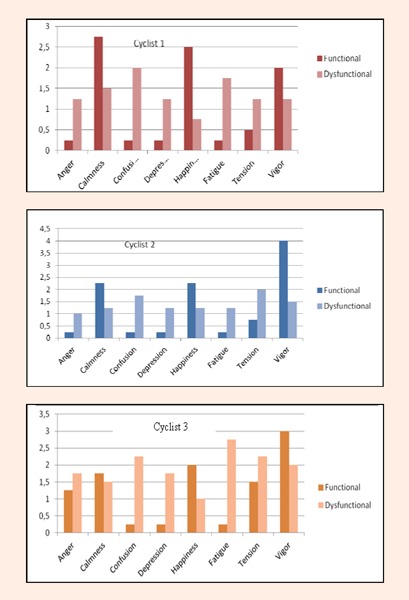
Emotions that riders experienced when performing successfully (Optimal-Functional) and unsuccessfully (Dysfunctional)
When emotional states were examined over the course of the RAAM, that is, each time a rider completed the emotion measure; results indicated that cyclists reported experiencing an optimal emotional state for less than 50% of total competition (see Figure 2). Further, emotions changed significantly each day (X2 = 13.2, p = .04). The most dramatic change occurred between days one and two in which cyclists reported an emotional profile similar to the one reported for dysfunctional performance (Figure 2).
Figure 2.
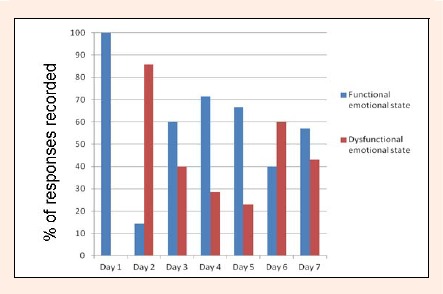
Percentage of assessment in either an Functional and Dysfunctional emotional states experienced during the RAAM
Qualitative data provide accounts of the acute challenges presented by the demands of the race. Quotes are used to illustrate the key themes. Cyclists reported anticipated emotions in relation to demands of the event and how they would cope with riding 12 h per day for a seven-day period. For example:
“Yeah, it was tough, you get on thinking I've had six hours recovery I'll be alright, within a minute (of riding) you're screwed again, you just have to sit on the rivet, to pretend it's going to be easy but it is bloody miserable”
“Very very good, big important session, Appalachian toughest part of race, really worked well as a team, depleted in numbers when X had to stop early due to fatigue. Everything came together really good result”
Riders also expressed aspects of the race where they experienced pleasant emotions. For example:
“Outstanding, best session so far, felt the strongest throughout the whole race, got lost but we worked really hard, closing the gap on the people in front”
“My first big decent downhill in California - 25miles of hairpin madness. 62miles per hour - lost the support vehicle behind - overtook 30 cars on the wrong side of the road - no pedaling - flat out pure joy - so much gravel on the road almost went down once - very scary, in fact the closest I have ever come to death without exaggeration - but still the most memorable experience on a bike going downhill in my life - just magic”
A source of intense emotions came from cyclists having difficulty regulating emotions when interacting with members of the support crew and other team cyclists. Incidents tended to occur around food and sleep related issues. For example, one cyclist expressed the following quote after being offered a meal that was not the food he requested.
“Pure rage - how could the f***ers not understand that cyclists needed food - then they are taking the piss out of me just because I wanted proper food.”
Cyclists also indicated how relationships with other members could influence their emotions. For example, following the incident from the quote above where the cyclist visibly lost his temper, the cyclist expressed the following quote:
“I went to bed hungry and pissed off. The only person who I found comfort from was XX (support crew) - they did not say a word, just made me some toast and rubbed my calves. Just a nod was good enough for me to realise that he knew what I was going through and that next time he would take control and get this done.”
The importance of team building is illustrated through the following two quotes. Here the cyclist speaks about the perceived sense of support from another cyclist motivating him. Whereas in the second quote speaks about anticipatory anger based on how other cyclists and support members might be judging him.
“My interaction with my crew and cyclist X. I had such a joyous time that I can put my hand on my heart and say that we did not have one cross word. When I was bolloxed cyclist X and crew would encourage me and vice versa”.
“After my first three hour ride I felt very sick and started to be very ill and vomit. I could only drink water and not any of the energy drink - however, I was about to start my 1st 6hr night shift and felt very nervous that I wouldn't make it through as I felt the pace of the firstthree hours. My fear is being thought of as not doing my share and shirking any riding time, because if someone else did that it would make me annoyed”
Sleep measures
On average cyclists managed less than 2.4 h of sleep per day. Furthermore, actual sleep time and efficiency of sleep during the RAAM were low in relation to baseline values (sleep time = 130 ± 17 vs. 431 ± 21 min; sleep efficiency = 24 ± 4 vs. 84 ± 2 %), whereas sleep latency and percentage moving time values increased (sleep latency = 19 ± 12 vs. 83 ± 6 min; % moving time = 47 ± 4 vs. 21 ± 5%) (Figure 3 and Table 1). Cyclists attained an almost three-fold increase in the amount of actual sleep and higher sleep efficiency during long compared to short sleep episodes (Table 1). Actual sleep and sleep efficiency (Figure 4) were maintained better in these long sleep episodes as the race progressed, with greater deteriorations in sleep quality and quantity during short sleep episodes. Although the amount of sleep and sleep efficiency recorded declined as the event progressed (Figures 3 and 4), there was considerable intra-individual variation. For example, in the last six sleep attempts cyclist 2 recorded just nine minutes of sleep in contrast to 129 and 173 min for cyclists 1 and 3.
Figure 3.
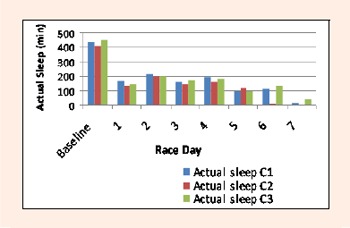
Actual sleep (min) at baseline and on each race day over the RAAM (C1= Cyclist 1, C2 = Cyclist 2, and C3=Cyclist 3)
Table 1.
Mean (±SD) values for sleep measures for RAAM cyclists
| Baseline | Daily Average | Short sleep (≤ 3 h) | Long sleep (≥ 3 h) | |
|---|---|---|---|---|
| Cyclist 1 | ||||
| Actual Sleep time (min) | 436.0 (39.6) | 138.6 (68.8) | 24.5 (27.0) | 108.5 (11.4) |
| Sleep Efficiency (%) | 84.5 (4.0) | 25.0 (12.0) | 20.1 (13.0) | 31.6 (6.9) |
| Sleep Latency (min) | 32.0 (15.6) | 85.2 (43.1) | 77.4 (43.0) | 95.7 (44.7) |
| % Moving time (%) | 21.3 (3.4) | 51.4 (14.1) | 49.7 (20.4) | 53.7 (8.9) |
| Cyclist 2 | ||||
| Actual Sleep time (min) | 408.0 (28.6) | 110.1 (76.6) | 16.5 (20.2) | 92.7 (30.3) |
| Sleep Efficiency (%) | 81.6 (2.7) | 19.6 (11.0) | 14.1 (10.2) | 26.9 (7.4) |
| Sleep Latency (min) | 12.3 (6.0) | 86.8 (56.1) | 82.6 (57.1) | 92.3 (59.7) |
| % Moving time (%) | 24.9 (3.1) | 46.3 (29.3) | 43.6 (29.3) | 50.1 (31.6) |
| Cyclist 3 | ||||
| Actual Sleep time (min) | 449.0 (35.2) | 140.1 (55.6) | 33.2 (24.8) | 91.7 (21.5) |
| Sleep Efficiency (%) | 85.2 (3.2) | 26.3 (6.9) | 25.1 (6.6) | 28.0 (7.7) |
| Sleep Latency (min) | 11.3 (8.0) | 76.1 (50.3) | 73.4 (37.6) | 67.5 (73.3) |
| % Moving time (%) | 15.2 (4.9) | 44.6 (17.3) | 38.5 (16.3) | 53.6 (15.7) |
Figure 4.
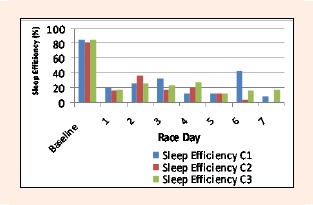
Sleep efficiency at baseline and on each race day over the RAAM (C1= Cyclist 1, C2 = Cyclist 2, and C3=Cyclist 3)
Discussion
The present study examined the emotional responses of cyclists when competing in a four-man team in the RAAM. All cyclists were found to be in a sleep deprived and negative energy balance state from the first day of the race (Hulton et al., 2010). The fluctuation of emotions documented throughout the RAAM is consistent with previous research that has examined emotional profiles in multistage ultra-endurance athletes (Lane and Wilson, 2011; Pedlar et al., 2007). In the present study, we examined emotional state in relation to whether cyclists were close to their self-reported optimal emotional state. Consistent with previous research (Hanin, 2010), optimal-functional emotional states were individualised. As Figure 1 indicates, cyclist three indicated that moderately high scores of anger and tension were associated with optimal performance. He also reported scores that were close to the maximum score on the self-report scale for the same two emotions when he performed poorly (Hanin, 2010; Lane et al., 2011); hence there was a small difference in intensity of anger and tension between optimal and dysfunctional performance.
The individualised nature of beliefs related to emotional states associated with functional performance presents a challenge for an athlete or member of a support crew wishing to help athlete manage emotional states. We suggest that identification of emotions that athletes believe are functional represents a starting point for applied work designed to help emotion regulation. However, it is worth noting that there was greater consistency between the three cyclists for emotional profiles associated with dysfunctional performance, consistent with an inverse iceberg profile (Raglin and Morgan, 1994).
Qualitative results indicated that there were instances where cyclists anticipated physiological sensations as an indication of effort made towards attaining personal goals. If a cyclist perceived he was likely to attain performance goals, then sensations of fatigue coincided with also experiencing pleasant emotions (Beedie et al., 2012; Lane and Wilson, 2011). However, fatigue did not always correlate with feeling pleasant emotions, but also coupled an increase in unpleasant emotions in certain situations. In such instances, frustration resulted when cyclists began to interpret sensations of fatigue as being indicative of their inability to cope (Beedie et al., 2012). The incident when the cyclist became angry over the food prepared for him is indicative of this point. The cyclist held firm beliefs that one type of food would be beneficial for recovery and the discrepancy with what was provided served to engender a belief that he would not be able to perform adequately in the next ride. Qualitative comments indicate that cyclists held beliefs on the need to maintain the race pacing strategy and anticipated the emotional states of other cyclists. In short, each cyclist expressed the idea of not performing poorly so as not to let the other cyclist down and such thoughts were accompanied by unpleasant emotions.
Qualitative data also indicate how cyclists regulated their emotions against a backdrop of insufficient sleep and difficulties maintaining energy requirements. Extrapolating arguments within the strength model (Gailliot and Baumeister, 2007), acts of self-control should have been progressively more difficult as the event continued. During the RAAM, cyclists experienced dysfunctional emotions during the early and later stages of the event. However, research has emphasised the role of motivational factors on self-control. Beedie and Lane, 2011 recently proposed a resource allocation model, arguing that individuals will seek to recruit more resources if situational demands require them. Qualitative results indicate the importance of maintaining the race strategy and how cyclists sought to allocate resources required to ride at the proposed intensity for the riding itself. Accordingly, strong beliefs in emotional control associate with regulating emotional states at an optimal intensity, requiring fewer resources (Niven et al., 2013). Therefore, strategies that promote developing strong beliefs in being able to control emotions may be beneficial for athletes wishing to participate in multiday ultra-endurance events.
Possibly the most important variable impacting upon multiday ultra-endurance performance is recovery between bouts. The present study demonstrates progressive sleep disruption for all cyclists, evidenced by the low sleep efficiency, and high sleep latency and percentage moving times (Table 1). Yet the most controllable factor affecting sleep is how the cyclists approached the cycle to rest strategy. The cycle to rest and sleep strategy was designed to promote sufficient recovery and maintain the target speed (8.94 m·s-1 or 20 mph), constructed by two sets of 3h blocks and one 6h block of cycling time. Results demonstrated that cyclists attained an almost three-fold increase in the amount of actual sleep and higher sleep efficiency during 6h rest periods compared to 3h rest periods. Thus, the strategy of two 3h work periods during the day may have in fact increased the possibility of increasing physiological and psychological fatigue caused by a lack of both non-Rapid Eye Movement (REM) and REM sleep.
In normal conditions as sleep progresses, the amount of time spent in non-REM decreases, whilst REM sleep significantly increases (Horne, 2000). Yet when sleep is partially deprived (< 4h), the duration of REM decreases (Belenky et al., 2003). Given the low actual sleep times observed during the two daily 3h rest bouts, it is reasonable to assume that non-REM sleep would have been severely impacted and REM sleep would have been extremely low throughout the RAAM. During Non-REM sleep, brain and core body temperature decrease, providing several responses including lowering energy utilisation, and reducing cerebral metabolism, protecting the brain against the sustained high temperatures of wakefulness, and facilitation of immune defense processes (McGinty and Szymusiak, 1990). Therefore, given the cyclists sleep deprived states, the proposed thermoregulatory and potential energy restoration benefits of non-REM sleep are potentially lost, resulting in cyclists experiencing greater energy losses and decreased feeding drives as a consequence of REM deprivation.
The second factor affecting emotion regulation is based upon cyclists trying to sleep/recover during daylight hours, thus attempting sleeping at unfavorable times during the circadian cycle. When sleep is attempted at a time during the circadian cycle not optimal for a major sleep episode, i.e. when core body temperature is high and levels of circulating melatonin are low, the consequence can be either difficulty falling asleep (increased sleep latency), or early morning awakenings (Lack and Wright, 2007a). Either result has the ultimate effect of lowering the total amount of sleep time (Lack and Wright, 2007b). All cyclists experienced increased sleep latencies compared to baseline levels, consistent with the effects of a desynchronisation between endogenous circadian rhythm and sleep-wake cycles (Liu et al. , 2000). It is also noteworthy that not only did cyclist two (Figure 3) have the lowest amount of actual sleep (Table 1), but also had the greatest difficulty falling asleep.
When seen collectively, results demonstrate poor sleep duration and quality, and inadequate energy intake, all of which may have impacted upon the cyclist's emotional regulation. Our data suggests that RAAM strategies should focus upon lengthening sleep periods promoting REM sleep, to potentially decrease wakefulness and sleep latency leading to the possibility of improved physiological recovery, enhanced emotion regulation, improved feeding strategies and most importantly, increased average velocity.
There are two limitations to the present study. The first limitation is the small sample size, although it should be noted that other studies have used small sample sizes (Pedlar et al., 2007; Smith et al., 1998). Secondly, our data do not generalise to women and may not be representative of female endurance cyclists; who represent a growing athletic population that require further investigation in their own right. The intention of the present study was not to suggest findings that generalise to other ultra-endurance groups, but offer a case study that illustrates intra-individual differences. The case in point is clearly illustrated by the results that show beliefs on the perceived functionality of emotions are highly individualised (see Figure 1).
Conclusion
Multiday ultra-endurance races such as the RAAM present athletes with a significant number of physiological and psychological challenges. Cyclists reported experiencing an optimal emotional state for less than 50% of total competition, with emotional states differing significantly between each cyclist over time. Coupled with this emotional disturbance was a progressively worsening sleep deprivation and negative energy balance throughout the RAAM. Cyclists managed less than one hour of continuous sleep per sleep episode, high sleep latency and high percentage moving time. Importantly, our data demonstrates that actual sleep and sleep efficiency was better maintained during longer rest periods, highlighting the importance of a correct cycling performance strategy, augmenting both average cycling velocity and sleep time. Our data appears to suggest that future RAAM cyclists and crew should 1) plan for enhanced sleep and recovery not just plan and train for maintaining a high average velocity, 2) create practical nutritional feeding strategies that encourage a greater energy intake, thus reducing energy deficits, and finally, 3) psychologically prepare cyclists and crew for the deleterious effects of sleep deprivation.
Acknowledgements
The contribution of Lane was supported by ESRC grant RES-060-25-0044: Emotion regulation of others and self (EROS).
Biographies
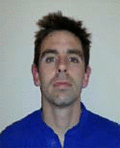
Ian M. Lahart
Employment
Lecturer in Sport and Exercise Physiology, School of Sport, Performing Arts and Leisure, University of Wolverhampton, UK
Degrees
BA, PGCERT, MSc
Research interest
Endurance performance, exercise and breast cancer
E-mail: i.lahart@wlv.ac.uk

Andrew M. Lane
Employment
Professor in Sport and Exercise Psychology, School of Sport, Performing Arts and Leisure, University of Wolverhampton, UK
Degrees
BA, PGCE, MSc, PhD
Research interest
Mood, emotion, measurement, coping, and performance
E-mail: A.M.Lane2@wlv.ac.uk

Andrew Hulton
Employment
Lecturer at Liverpool John Moores University, Research Institute of Sport and Exercise Sciences, UK
Degrees
BSc, MSc, PhD
Research interest
Pre-exercise nutrition, ergogenic aids, intermittent exercise, and recovery strategies.
E-mail: a.t.hulton@ljmu.ac.uk

Karen Williams
Employment
Manager of the Surrey Human Performance Institute at the University of Surrey Clinical Research Centre.
Degrees
BSc (Hons), MSc, PGCE.
Research interest
Cardiovascular Physiology
E-mail: k.williams@surrey.ac.uk
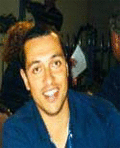
Richard Godfrey
Employment
Senior Lecturer, Brunel University, UK
Degrees
BSc, PhD.
E-mail: Richard.godfrey@brunel.ac.uk

Charles Pedlar
Employment
Academic Director, Centre for Health, Applied Sport and Exercise Science, School of Sport, Health and Applied Science, St Mary's University College, Twickenham, UK
Degrees
BSc (Hons), MSc, PhD
Research interest
Endurance performance, altitude, sleep, female athlete triad, running
E-mail: pedlarc@smuc.ac.uk
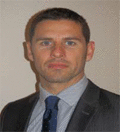
Mathew G. Wilson
Employment
Cardiovascular Physiologist, Department of Sports Medicine, ASPETAR, Qatar Orthopedic and Sports Medicine Hospital, Doha.
Degrees
BSc, MPhil, PhD
Research interest
Sports Cardiology, Cardiovascular Physiology, Endurance Performance
Email: Mathew.wilson@aspetar.com
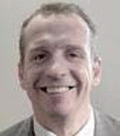
Gregory P. Whyte
Employment
Professor of Applied Sports Science
Degrees
BSc, PGCE, MSc, PhD
Research interest
Cardiac damage, environmental physiology, appliedsport science research
E-mail: gregwhyte27@yahoo.co.uk
References
- Adam K., Oswald I. (1983) Protein synthesis, bodily renewal and the sleep-wake cycle. Clinical Science (Lond) 65, 561-567 [DOI] [PubMed] [Google Scholar]
- Ancoli-Israel S., Cole R., Alessi C., Chambers M., Moorcroft W., Pollak C.P. (2003) The role of actigraphy in the study of sleep and circadian rhythms. Sleep 26, 342-392 [DOI] [PubMed] [Google Scholar]
- Beedie C.J., Lane A.M. (2012) The role of glucose in self-control: Another look at the evidence and an alternative conceptualization. Personality and Social Psychology Review 16(2),143-153 [DOI] [PubMed] [Google Scholar]
- Beedie C.J., Lane A.M., Wilson M. (2012) A possible role for emotion and emotion regulation in physiological responses to false performance feedback in 10km laboratory cycling. Applied Psychophysiology and Biofeedback 37(4), 269-277 [DOI] [PubMed] [Google Scholar]
- Beedie C.J., Terry P.C., Lane A.M. (2000) The Profile of Mood States and athletic Performance: Two meta-analyses. Journal of Applied Sport Psychology 12, 49-68 [Google Scholar]
- Belenky G., Wesensten N.J., Thorne D.R., Thomas M.L., Sing H.C., Redmond D.P. (2003) Patterns of performance degradation and restoration during sleep restriction and subsequent recovery: a sleep dose-response study. Journal of Sleep Research 12, 1-12 [DOI] [PubMed] [Google Scholar]
- Bowen R.L., Adams J.H., Myburgh K.H. (2006) Nausea and high serum osmolality during a simulated ultraendurance adventure race: a case-control study. International Journal of Sports Physiology and Performance 1, 176-185 [DOI] [PubMed] [Google Scholar]
- Burke L.M. (2001) Nutritional practices of male and female endurance cyclists. Sports Medicine 31, 521-532 [DOI] [PubMed] [Google Scholar]
- Devonport T.J., Lane A.M., Hanin Y. (2005) Affective state profiles of athletes prior to best, worst and performance-induced injury outcomes. Journal of Sports Science and Medicine 4, 382-394 [PMC free article] [PubMed] [Google Scholar]
- Devonport T.J., Lane A.M., Lloyd J. (2011) Keeping your cool: A case study of a female explorer's solo North Pole expedition. Journal of Human Performance in Extreme Environment 22, 333-337 [DOI] [PubMed] [Google Scholar]
- Driver H.S., Taylor S.R. (2000) Exercise and sleep. Sleep Medicine Reviews 4, 387-402 [DOI] [PubMed] [Google Scholar]
- Gailliot M.T., Baumeister R.F. (2007) The physiology of willpower: Linking blood glucose to self-control. Personality and Social Psychology Review 11, 303-327 [DOI] [PubMed] [Google Scholar]
- Hagger M.S., Wood C., Stiff C., Chatzisarantis N.L. (2010) Ego depletion and the strength model of self-control: a meta-analysis. Psychological Bulletin 136(4), 495-525 [DOI] [PubMed] [Google Scholar]
- Hanin Y.L. (2010) Coping with anxiety in sport. Coping in sport: Theory, methods, and related constructs. Nicholls A.R.Hauppauge, NY: Nova Science; 159-175 [Google Scholar]
- Horne J.A. (2000) REM sleep - by default?. Neuroscience and Biobehavioral Reviews 24, 777-797 [DOI] [PubMed] [Google Scholar]
- Hulton A.T., Lahart I., Williams K.L., Godfrey R., Charlesworth S., Wilson M., Pedlar C., Whyte G. (2010) Energy expenditure in the Race Across America (RAAM). International Journal of Sports Medicine 31, 463-467 [DOI] [PubMed] [Google Scholar]
- Jeukendrup A.E., Jentjens R.L., Moseley L. (2005) Nutritional considerations in triathlon. Sports Medicine 35, 163-181 [DOI] [PubMed] [Google Scholar]
- Jeukendrup A., Brouns F., Wagenmakers A.J., Saris W.H. (1997) Carbohydrate-electrolyte feedings improve 1 h time trial cycling performance. International Journal of Sports Medicine 18, 125-129 [DOI] [PubMed] [Google Scholar]
- Johansson P., Dahlstrom U., Brostrom A. (2006) Factors and interventions influencing health-related quality of life in patients with heart failure: a review of the literature. European Journal of Cardiovascular Nursing 5, 5-15 [DOI] [PubMed] [Google Scholar]
- Knechtle B., Enggist A., Jehle T. (2005) Energy turnover at the Race Across AMerica (RAAM) - a case report. International Journal of Sports Medicine 26, 499-503 [DOI] [PubMed] [Google Scholar]
- Lack L.C., Wright H.R. (2007a) Treating chronobiological components of chronic insomnia. Sleep Medicine 8, 637-644 [DOI] [PubMed] [Google Scholar]
- Lack L.C., Wright H.R. (2007b) Chronobiology of sleep in humans. Cellular and Molecular Life Sciences 64, 1205-1215 [DOI] [PMC free article] [PubMed] [Google Scholar]
- Lane A.M., Wilson (2011) Emotions and emotional intelligence among ultra-endurance runners. Journal of Science and Medicine in Sport 14, 358-362 [DOI] [PubMed] [Google Scholar]
- Lane A.M., Beedie C.J., Devonport T.J., Stanley D.M. (2011) Instrumental emotion regulation in sport: relationships between beliefs about emotion and emotion regulation strategies used by athletes. Scandinavian Journal of Medicine & Science in Sports 21, e445-e451 [DOI] [PubMed] [Google Scholar]
- Lane A.M., Beedie C.J., Jones M.V., Uphill M., Devonport T.J. (2012) The BASES Expert Statement on emotion regulation in sport. Journal of Sports Sciences 30(11), 1189-1195 [DOI] [PubMed] [Google Scholar]
- Liu X., Uchiyama M., Shibui K., Kim K., Kudo Y., Tagaya H. (2000) Diurnal preference, sleep habits, circadian sleep propensity and melatonin rhythm in healthy human subjects. Neuroscience Letters 280, 199-202 [DOI] [PubMed] [Google Scholar]
- Matthews G., Jones D.M., Chamberlain A.G. (1990) Refining the measurement of mood: The UWIST Mood Adjective Checklist. British Journal of Psychology 81, 17-42 [Google Scholar]
- McGinty D., Szymusiak R. (1990) Keeping cool: a hypothesis about the mechanisms and functions of slow-wave sleep. Trends in Neurosciences 13, 480-487 [DOI] [PubMed] [Google Scholar]
- Niven K., Totterdell P., Miles E., Sheeran P., Webb T. (2013). Achieving the same for less: Improving mood depletes blood glucose for people with poor (but not good) emotion control. Cognition & Emotion 27(1), 133-140 [DOI] [PubMed] [Google Scholar]
- Pedlar C.R., Lane A.M., Lloyd J.C., Dawson J., Emegbo S., Stanley N. (2007) Sleep profiles and mood state changes during an expedition to the South Pole: a case study of a female explorer. Wilderness and Environmental Medicine 18, 13-25 [DOI] [PubMed] [Google Scholar]
- Raglin J.S., Morgan WP. (1994) Development of a scale for use in monitoring training-induced distress in athletes. International Journal of Sports Medicine 15, 84-88 [DOI] [PubMed] [Google Scholar]
- Sadeh A., Hauri P.J., Kripke D.F., Lavie P. (1995) The role of actigraphy in the evaluation of sleep disorders. Sleep 18, 288-302 [DOI] [PubMed] [Google Scholar]
- Schumacher Y.O., Ahlgrim C., Prettin S., Pottgiesser T. (2011) Physiology, power output, and racing strategy of a Race Across America finisher. Medicine and Science in Sports and Exercise 43(5), 885-889 [DOI] [PubMed] [Google Scholar]
- Smith R. S., Walsh J., Dement W. (1998) Sleep deprivation and the race across America. Journal of Sleep 22, 303-304 [Google Scholar]
- Stanley D.M., Beedie C.J., Lane A.M., Friesen A.P., Devonport T.J. (2012). Emotion regulation strategies used by runners prior to training and competition. International Journal of Sport and Exercise Psychology 10, 159-171 [Google Scholar]
- Terry P.C., Lane A.M., Fogarty G.J. (2003) Construct validity of the Profile of Mood States - Adolescents for use with adults. Psychology of Sport and Exercise 4, 125-139 [Google Scholar]
- Walsh R.M., Noakes T.D., Hawley J.A., Dennis S.C. (1994) Impaired high-intensity cycling performance time at low levels of dehydration. International Journal of Sports Medicine 7, 392-398 [DOI] [PubMed] [Google Scholar]
- Williams K., George K., Hulton A., Godfrey R., Lahart I., Wilson M.G., Charlesworth S., Warburton D., Gaze D., Whyte G. (2011) A unique case series of novel biomarkers of cardiac damage in cyclists completing the 4800 km Race Across America (RAAM). Current medicinal chemistry 18(23), 3446-3451 [DOI] [PubMed] [Google Scholar]


